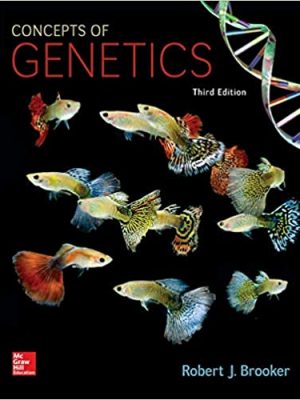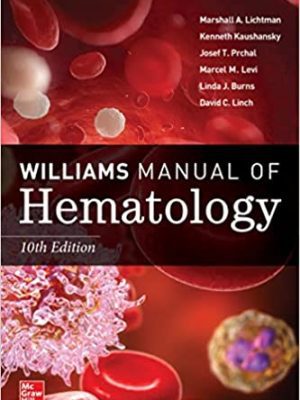Williams Manual of Hematology 10th Edition
Williams Manual of Hematology Tenth Edition:
Additional ISBNs:
∗ eText ISBN: 1264269218, 978-1264269211, 9781264269211
Table of Contents
Part I: Clinical Evaluation of the Patient
Chapter 1: Initial Approach to the Patient: History and Physical Examination
Chapter 2: Examination of Blood and Marrow Cells
Chapter 3: Consultative Hematology
Part II: The Organization of the Lymphohematopoietic Tissues
Chapter 4: Structure of the Marrow and the Hematopoietic Microenvironment
Chapter 5: The Organization and Structure of Lymphoid Tissues
Part III: Epochal Hematology
Chapter 6: Hematology of the Fetus and Newborn
Chapter 7: Hematology During Pregnancy
Chapter 8: Hematology in Older Persons
Part IV: Molecular and Cellular Hematology
Chapter 9: Genetic Principles and Molecular Biology
Chapter 10: Genomics and Epigenomics
Chapter 11: Cytogenetic and Genetic Abnormalities
Chapter 12: Application of Big Data and Deep Learning in Hematology
Chapter 13: Metabolism of Hematologic Neoplastic Cells
Chapter 14: Cell Death
Chapter 15: Cell-Cycle Regulation and Hematologic Disorders
Chapter 16: Signal Transduction Pathways
Chapter 17: Hematopoietic Stem Cells, Progenitors, and Cytokines
Chapter 18: The Inflammatory Response
Chapter 19: Innate Immunity
Chapter 20: The Biology of Innate Lymphoid Cells and Natural Killer Cells
Chapter 21: Dendritic Cells and Adaptive Immunity
Part V: Therapeutic Principles
Chapter 22: Immune Checkpoint Inhibitors
Chapter 23: Immune Cell Therapy: Chimeric Antigen Receptor T-Cell Therapy
Chapter 24: Immune Cell Therapy: Dendritic Cell and Natural Killer Cell Therapy
Chapter 25: Vaccine Therapy
Chapter 26: Gene Therapy for Hematologic Diseases
Chapter 27: Regenerative Medicine: Induced Pluripotent Stem Cells And Blood Cell Engineering
Chapter 28: Pharmacology and Toxicity of Antineoplastic Drugs
Chapter 29: Hematopoietic Stem Cell Transplantation
Chapter 30: Therapeutic Apheresis: Indications, Efficacy, and Complications
Chapter 31: Treatment of Infections in the Immunocompromised Host
Chapter 32: Antithrombotic Therapy
Part VI: The Erythrocyte
Chapter 33: Structure and Composition of the Erythrocyte
Chapter 34: Erythropoiesis and Red Cell Turnover
Chapter 35: Clinical Manifestations and Classification of Erythrocyte Disorders
Chapter 36: Aplastic Anemia: Acquired and Inherited
Chapter 37: Pure Red Cell Aplasia
Chapter 38: Anemia of Chronic Disease
Chapter 39: Erythropoietic Effects of Endocrine Disorders
Chapter 40: The Hereditary Dyserythropoietic Anemias
Chapter 41: Paroxysmal Nocturnal Hemoglobinuria
Chapter 42: Folate, Cobalamin, and Megaloblastic Anemias
Chapter 43: Iron Metabolism
Chapter 44: Iron Deficiency and Overload
Chapter 45: Anemia Resulting from Other Nutritional Deficiencies
Chapter 46: Anemia Associated with Marrow Infiltration
Chapter 47: Erythrocyte Membrane Disorders
Chapter 48: Erythrocyte Enzyme Disorders
Chapter 49: Thalassemia: A Disorder of Globin Synthesis
Chapter 50: Disorders of Hemoglobin Structure: Sickle Cell Anemia and Related Abnormalities
Chapter 51: Methemoglobinemia and Other Dyshemoglobinemias
Chapter 52: Fragmentation Hemolytic Anemia
Chapter 53: Erythrocyte Disorders as a Result of Toxic Agents
Chapter 54: Hemolytic Anemia Resulting from Infections with Microorganisms
Chapter 55: Hemolytic Anemia Resulting from Immune Injury
Chapter 56: Alloimmune Hemolytic Disease of the Fetus and Newborn
Chapter 57: Hypersplenism and Hyposplenism
Chapter 58: Primary and Secondary Erythrocytoses/Polycythemias
Chapter 59: The Porphyrias
Chapter 60: Polyclonal and Hereditary Sideroblastic Anemias
Part VII: Neutrophils, Eosinophils, Basophils, and Mast Cells
Chapter 61: Structure and Composition of Neutrophils, Eosinophils, and Basophils
Chapter 62: Classification and Clinical Manifestations of Neutrophil Disorders
Chapter 63: Neutropenia and Neutrophilia
Chapter 64: Disorders of Neutrophil Function
Chapter 65: Eosinophils and Their Disorders
Chapter 66: Basophils and Mast Cells and Their Disorders
Part VIII: Monocytes and Macrophages
Chapter 67: Structure, Receptors, and Functions of Monocytes and Macrophages
Chapter 68: Production, Distribution, and Activation of Monocytes and Macrophages
Chapter 69: Classification and Clinical Manifestations of Disorders of Monocytes and Macrophages
Chapter 70: Monocytosis and Monocytopenia
Chapter 71: Inflammatory and Malignant Histiocytosis
Chapter 72: Gaucher Disease and Related Lysosomal Storage Diseases
Part IX: Lymphocytes and Plasma Cells
Chapter 73: The Structure of Lymphocytes and Plasma Cells
Chapter 74: Lymphopoiesis
Chapter 75: Functions of B Lymphocytes and Plasma Cells in Immunoglobulin Production
Chapter 76: Functions of T Lymphocytes: T-Cell Receptors for Antigen
Chapter 77: Classification and Clinical Manifestations of Lymphocyte and Plasma Cell Disorders
Chapter 78: Lymphocytosis and Lymphocytopenia
Chapter 79: Immunodeficiency Diseases
Chapter 80: Hematologic Manifestations of Human Immunodeficiency Virus and the Acquired Immunodeficiency Syndrome
Chapter 81: Mononucleosis Syndromes
Part X: Malignant Myeloid Diseases
Chapter 82: Classification and Clinical Manifestations of the Clonal Myeloid Disorders
Chapter 83: Polycythemia Vera
Chapter 84: Essential Thrombocythemia
Chapter 85: Primary Myelofibrosis
Chapter 86: Myelodysplastic Syndromes
Chapter 87: Acute Myelogenous Leukemia
Chapter 88: Chronic Myelogenous Leukemia and Related Disorders
Part XI: Malignant Lymphoid Diseases
Chapter 89: Classification of Malignant Lymphoid Disorders
Chapter 90: Acute Lymphoblastic Leukemia
Chapter 91: Chronic Lymphocytic Leukemia
Chapter 92: Hairy Cell Leukemia
Chapter 93: Large Granular Lymphocytic Leukemia
Chapter 94: General Considerations of Lymphomas: Incidence Rates, Etiology, Diagnosis, Staging, and Primary Extranodal Disease
Chapter 95: Pathology of Lymphomas
Chapter 96: Hodgkin Lymphoma
Chapter 97: Diffuse Large B-Cell Lymphoma and Related Diseases
Chapter 98: Follicular Lymphoma
Chapter 99: Mantle Cell Lymphoma
Chapter 100: Marginal Zone B-Cell Lymphomas
Chapter 101: Burkitt Lymphoma
Chapter 102: Cutaneous T-Cell Lymphoma (Mycosis Fungoides and Sézary Syndrome)
Chapter 103: Mature T-Cell and Natural Killer Cell Lymphomas
Chapter 104: Plasma Cell Neoplasms: General Considerations
Chapter 105: Essential Monoclonal Gammopathy
Chapter 106: Myeloma
Chapter 107: Immunoglobulin Light Chain Amyloidosis
Chapter 108: Macroglobulinemia
Chapter 109: Heavy-Chain Disease
Part XII: Hemostasis and Thrombosis
Chapter 110: Megakaryopoiesis and Thrombopoiesis
Chapter 111: Platelet Morphology, Biochemistry, and Function
Chapter 112: Molecular Biology and Biochemistry of the Coagulation Factors and Pathways of Hemostasis
Chapter 113: Control of Coagulation Reactions
Chapter 114: Vascular Function in Hemostasis
Chapter 115: Classification, Clinical Manifestations, and Evaluation of Disorders of Hemostasis
Chapter 116: Thrombocytopenia
Chapter 117: Heparin-Induced Thrombocytopenia
Chapter 118: Hereditary and Reactive Thrombocytosis
Chapter 119: Inherited Platelet Disorders
Chapter 120: Acquired Qualitative Platelet Disorders
Chapter 121: The Vascular Purpuras
Chapter 122: Hemophilia A and Hemophilia B
Chapter 123: Inherited Deficiencies of Coagulation Factors II, V, V+VIII, VII, X, XI, and XIII
Chapter 124: Hereditary Fibrinogen Abnormalities
Chapter 125: VON Willebrand Disease
Chapter 126: Antibody-Mediated Coagulation Factor Deficiencies
Chapter 127: Disseminated Intravascular Coagulation
Chapter 128: Thrombotic Microangiopathies
Chapter 129: Hemolytic Uremic Syndrome
Chapter 130: Hemostatic Alterations in Liver Diseases and Liver Transplantation
Chapter 131: Hereditary Thrombophilia
Chapter 132: The Antiphospholipid Syndrome
Chapter 133: Venous Thrombosis
Chapter 134: Atherothrombosis: Disease Initiation, Progression, and Treatment
Chapter 135: Fibrinolysis and Thrombolysis
Part XIII: Transfusion Medicine
Chapter 136: Erythrocyte Antigens and Antibodies
Chapter 137: Human Leukocyte and Platelet Antigens
Chapter 138: Blood Procurement and Red Cell Transfusion
Chapter 139: Preservation and Clinical use of Platelets
Chapter 140: Using Plasma and Plasma Component Therapy




























 Dentistry
Dentistry
Reviews
There are no reviews yet.